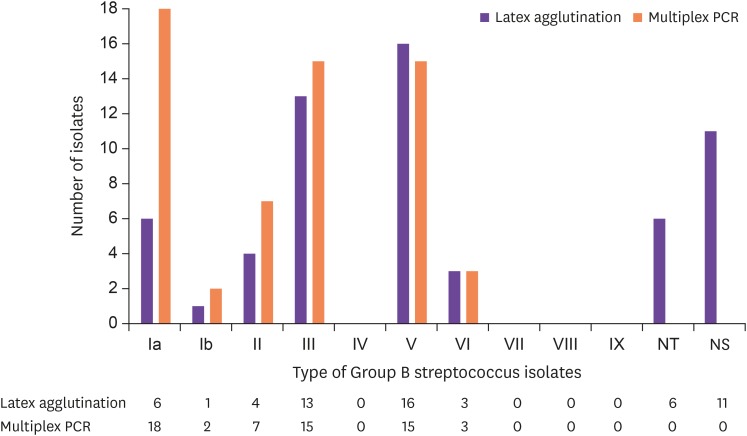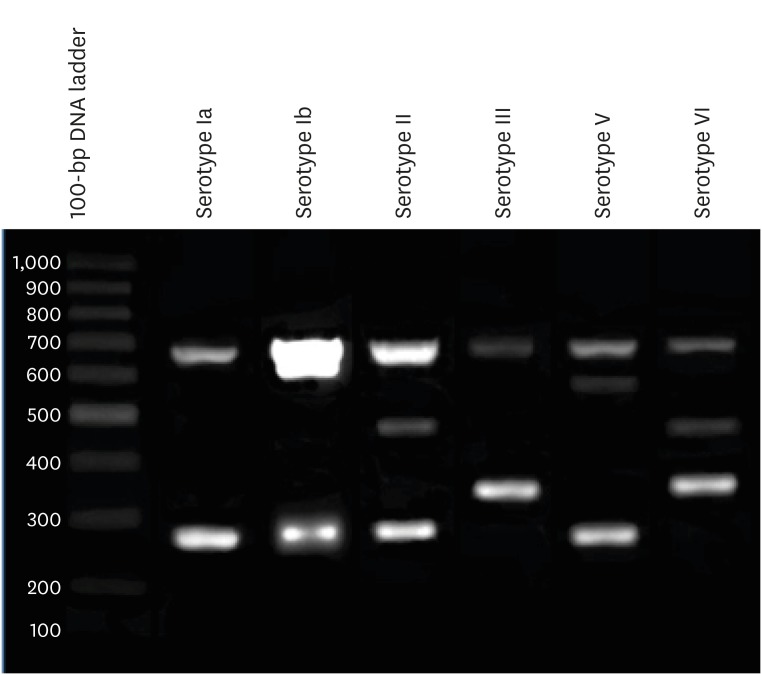1. Verani JR, McGee L, Schrag SJ; Division of Bacterial Diseases, National Center for Immunization and Respiratory Diseases, Centers for Disease Control and Prevention (CDC). Prevention of perinatal group B streptococcal disease-revised guidelines from CDC 2010. MMWR Recomm Rep. 2010; 59(RR-10):1–36.
2. Ippolito DL, James WA, Tinnemore D, Huang RR, Dehart MJ, Williams J, Wingerd MA, Demons ST. Group B streptococcus serotype prevalence in reproductive-age women at a tertiary care military medical center relative to global serotype distribution. BMC Infect Dis. 2010; 10:336. PMID:
21106080.

3. Alhhazmi A, Hurteau D, Tyrrell GJ. Epidemiology of invasive group B streptococcal disease in Alberta, Canada, from 2003 to 2013. J Clin Microbiol. 2016; 54:1774–1781. PMID:
27098960.

4. Kunze M, Ziegler A, Fluegge K, Hentschel R, Proempeler H, Berner R. Colonization, serotypes and transmission rates of group B streptococci in pregnant women and their infants born at a single university center in Germany. J Perinatal Med. 2011; 39:417–422.

5. Wang P, Ma Z, Tong J, Zhao R, Shi W, Yu S, Yao K, Zheng Y, Yang Y. Serotype distribution, antimicrobial resistance, and molecular characterization of invasive group B streptococcus isolates recovered from Chinese neonates. Int J Infect Dis. 2015; 37:115–118. PMID:
26141418.

6. Madzivhandila M, Adrian PV, Cutland CL, Kuwanda L, Schrag SJ, Madhi SA. Serotype distribution and invasive potential of group B streptococcus isolates causing disease in infants and colonizing maternal-newborn dyads. PLoS One. 2011; 6:e17861. PMID:
21445302.

7. Kobayashi M, Vekemans J, Baker CJ, Ratner AJ, Le Doare K, Schrag SJ. Group B Streptococcus vaccine development: present status and future considerations, with emphasis on perspectives for low and middle income countries. F1000 Res. 2016; 5:2355.
8. Park CH, Vandel NM, Ruprai DK, Martin EA, Gates KM, Coker D. Detection of group B streptococcal colonization in pregnant women using direct latex agglutination testing of selective broth. J Clin Microbiol. 2001; 39:408–409. PMID:
11191227.

9. Benson JA, Flores AE, Baker CJ, Hillier SL, Ferrieri P. Improved methods for typing nontypeable isolates of group B streptococci. Int J Med Microbiol. 2002; 292:37–42. PMID:
12139427.

10. Manning SD, Lacher DW, Davies HD, Foxman B, Whittam TS. DNA polymorphism and molecular subtyping of the capsular gene cluster of group B streptococcus. J Clin Microbiol. 2005; 43:6113–6116. PMID:
16333106.
11. Poyart C, Tazi A, Réglier-Poupet H, Billoët A, Tavares N, Raymond J, Trieu-Cuot P. Multiplex PCR assay for rapid and accurate capsular typing of group B streptococci. J Clin Microbiol. 2007; 45:1985–1988. PMID:
17376884.

12. Imperi M, Pataracchia M, Alfarone G, Baldassarri L, Orefici G, Creti R. A multiplex PCR assay for the direct identification of the capsular type (Ia to IX) of
Streptococcus agalactiae
. J Microbiol Methods. 2010; 80:212–214. PMID:
19958797.
13. Clinical Laboratory Standards Institute (CLSI). Performance standards for antimicrobial susceptibility testing; Twenty-second informational supplement. M100-S22. Wayne, Pennsylvania: CLSI;2012.
14. Shabayek S, Spellerberg B. Group B streptococcal colonization, molecular characteristics, and epidemiology. Front Microbiol. 2018; 9:437. PMID:
29593684.

15. Russell NJ, Seale AC, O'Driscoll M, O'Sullivan C, Bianchi-Jassir F, Gonzalez-Guarin J, Lawn JE, Baker CJ, Bartlett L, Cutland C, Gravett MG, Heath PT, Le Doare K, Madhi SA, Rubens CE, Schrag S, Sobanjo-Ter Meulen A, Vekemans J, Saha SK, Ip M. GBS Maternal Colonization Investigator Group. Maternal colonization with group B
streptococcus and serotype distribution worldwide: systematic review and meta-analyses. Clin Infect Dis. 2017; 65(Suppl 2):S100–S111. PMID:
29117327.
16. Khan MA, Faiz A, Ashshi AM. Maternal colonization of group B streptococcus: prevalence, associated factors and antimicrobial resistance. Ann Saudi Med. 2015; 35:423–427. PMID:
26657224.

17. Musleh J, Al Qahtani N. Group B streptococcus colonization among Saudi women during labor. Saudi J Med Med Sci. 2018; 6:18–22. PMID:
30787811.

18. Arain FR, Al-Bezrah NA, Al-Aali KY. Prevalence of maternal genital tract colonization by group B streptococcus from Western Province, Taif, Saudi Arabia. J Clin Gynecol Obstet. 2015; 4:258–264.

19. El-Kersh TA, Neyazi SM, Al-Sheikh YA, Niazy AA. Phenotypic traits and comparative detection methods of vaginal carriage of Group B streptococci and its associated micro-biota in term pregnant Saudi women. African J Microbiol Res. 2012; 6:403–413.

20. El-Kersh TA, Al-Nuaim LA, Kharfy TA, Al-Shammary FJ, Al-Saleh SS, Al-Zamel FA. Detection of genital colonization of group B streptococci during late pregnancy. Saudi Med J. 2002; 23:56–61. PMID:
11938365.
21. Zamzami TY, Marzouki AM, Nasrat HA. Prevalence rate of group B streptococcal colonization among women in labor at King Abdul-Aziz university hospital. Arch Gynecol Obstet. 2011; 284:677–679. PMID:
21079981.

22. Slotved HC, Hoffmann S. Evaluation of procedures for typing of group B
Streptococcus: a retrospective study. PeerJ. 2017; 5:e3105. PMID:
28321367.
23. Savoia D, Gottimer C, Crocilla' C, Zucca M.
Streptococcus agalactiae in pregnant women: phenotypic and genotypic characters. J Infect. 2008; 56:120–125. PMID:
18166228.
24. Turner C, Turner P, Po L, Maner N, De Zoysa A, Afshar B, Efstratiou A, Heath PT, Nosten F. Group B streptococcal carriage, serotype distribution and antibiotic susceptibilities in pregnant women at the time of delivery in a refugee population on the Thai-Myanmar border. BMC Infect Dis. 2012; 12:34. PMID:
22316399.

25. Yao K, Poulsen K, Maione D, Rinaudo CD, Baldassarri L, Telford JL, Sørensen UB, Kilian M. Members of the DEVANI Study Group. Capsular gene typing of Streptococcus agalactiae compared to serotyping by latex agglutination. J Clin Microbiol. 2013; 51:503–507. PMID:
23196363.

26. Saha SK, Ahmed ZB, Modak JK, Naziat H, Saha S, Uddin MA, Islam M, Baqui AH, Darmstadt GL, Schrag SJ. Group B streptococcus among pregnant women and newborns in Mirzapur, Bangladesh: colonization, vertical transmission, and serotype distribution. J Clin Microbiol. 2017; 55:2406–2412. PMID:
28515218.

27. Brigtsen AK, Dedi L, Melby KK, Holberg-Petersen M, Radtke A, Lyng RV, Andresen LL, Jacobsen AF, Fugelseth D, Whitelaw A. Comparison of PCR and serotyping of Group B
Streptococcus in pregnant women: the Oslo GBS-study. J Microbiol Methods. 2015; 108:31–35. PMID:
25447890.
28. Jannati E, Roshani M, Arzanlou M, Habibzadeh S, Rahimi G, Shapuri R. Capsular serotype and antibiotic resistance of group B streptococci isolated from pregnant women in Ardabil, Iran. Iran J Microbiol. 2012; 4:130–135. PMID:
23066487.
29. Mansouri S, Ghasami E, Najad NS. Vaginal colonization of group B streptococci during late pregnancy in southeast of Iran: Incidence, serotype distribution and susceptibility to antibiotics. J Med Sci. 2008; 8:574–578.

30. Boswihi SS, Udo EE, Al-Sweih N. Serotypes and antibiotic resistance in Group B streptococcus isolated from patients at the Maternity hospital, Kuwait. J Med Microbiol. 2012; 61:126–131. PMID:
21903822.

31. Shabayek S, Abdalla S, Abouzeid AM. Serotype and surface protein gene distribution of colonizing group B streptococcus in women in Egypt. Epidemiol Infect. 2014; 142:208–210. PMID:
23561305.

32. Al Luhidan L, Madani A, Albanyan EA, Al Saif S, Nasef M, AlJohani S, Madkhali A, Al Shaalan M, Alalola S. Neonatal group B streptococcal infection in a tertiary care hospital in Saudi Arabia: A 13-year experience. Pediatr Infect Dis J. 2019; 38:731–734. PMID:
31192978.
33. Al-Samnan M, Al-Salam Z. Neonatal group B streptococcal sepsis: Retrospective study from a tertiary level hospital. Acad J Ped Neonatol. 2017; 5:70–72.
34. Florindo C, Damiao V, Silvestre I, Farinha C, Rodrigues F, Nogueira F, Martins-Pereira F, Castro R, Borrego MJ, Santos-Sanches I. Group for the Prevention of Neonatal GBS Infection. Epidemiological surveillance of colonising group B
Streptococcus epidemiology in the Lisbon and Tagus Valley regions, Portugal (2005 to 2012): emergence of a new epidemic type IV/clonal complex 17 clone. Euro Surveill. 2014; 19:pii: 20825.

35. Suhaimi MES, Desa MNM, Eskandarian N, Pillay SG, Ismail Z, Neela VK, Masri SN, Nordin SA. Characterization of a group B streptococcus infection based on the demographics, serotypes, antimicrobial susceptibility and genotypes of selected isolates from sterile and non-sterile isolation sites in three major hospitals in Malaysia. J Infect Public Health. 2017; 10:14–21. PMID:
27095302.

36. World Health Organization (WHO). WHO recommendations for prevention and treatment of maternal peripartum infection. Geneva: WHO;2015. p. 1–80.
37. Eren A, Küçükercan M, Oğuzoğlu N, Unal N, Karateke A. The carriage of group B streptococci in Turkish pregnant women and its transmission rate in newborns and serotype distribution. Turkish J Pediatr. 2005; 47:28–33.
38. Garland SM, Cottrill E, Markowski L, Pearce C, Clifford V, Ndisang D, Kelly N, Daley AJ. Australasian Group for Antimicrobial Resistance-GBS Resistance Study Group. Antimicrobial resistance in group B streptococcus: the Australian experience. J Med Microbiol. 2011; 60:230–235. PMID:
21030500.

39. Wang P, Tong JJ, Ma XH, Song FL, Fan L, Guo CM, Shi W, Yu SJ, Yao KH, Yang YH. Serotypes, antibiotic susceptibilities, and multi-locus sequence type profiles of
Streptococcus agalactiae isolates circulating in Beijing, China. PLoS One. 2015; 10:e0120035. PMID:
25781346.
40. Seo YS, Srinivasan U, Oh KY, Shin JH, Chae JD, Kim MY, Yang JH, Yoon HR, Miller B, DeBusscher J, Foxman B, Ki M. Changing molecular epidemiology of group B streptococcus in Korea. J Korean Med Sci. 2010; 25:817–823. PMID:
20514299.








 PDF
PDF ePub
ePub Citation
Citation Print
Print





 XML Download
XML Download